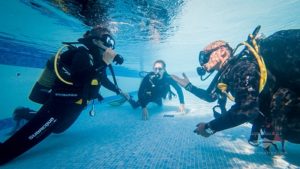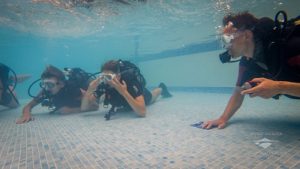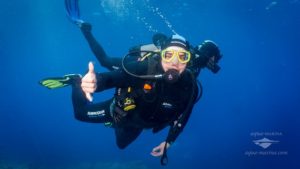What actually happens on a Discover Scuba Dive
If you or someone you know is curious to try diving, then the PADI Discover Scuba Diving programme is the best place to start!
Note: Some aspects of what is described here relate specifically to the way WE conduct this programme, and may be different in other dive centres.
The Discover Scuba Diving programme is a one-day activity designed to teach participants a little bit of basic fundamental dive theory; provide an opportunity to master some basic dive skills; and finally put all this together during a supervised exploration dive in open water.
Discover Scuba – Dive theory
The Discover Scuba Diving programme begins with a short presentation to make participants aware of a few concepts which they will need to know to dive safely. This isn’t at all complicated and includes an introduction to the effects of increased atmospheric pressure on a diver’s body; an explanation of the equipment; and a few simple hand signals to enable communication underwater.
This presentation covers all of the main points of the first of five chapters from the PADI Open Water Diver course.
Discover Scuba – Confined Water Practice
‘Confined water’ is a term used to describe a body of water which provides conditions comparable to a swimming pool with regards to clarity, calmness and depth. Obviously a swimming pool is ideal, however many lakes and beaches also offer suitable conditions for confined water training.
During the confined water training dive in the Discover Scuba Diving programme, participants are taught a few simple skills which will enable them to resolve problems which may arise during a dive.
Discover Scuba Divers are taught
- how to ‘equalise’ – to compensate the body air spaces against the increased ambient pressure during descent;
- how to clear water from the regulator in the event that some gets in there;
- how to find and retrieve the regulator in the highly unlikely event that it comes out of their mouth;
- how to clear water from the mask in the event that some trickles in during the dive;
- how to add air to the BCD to achieve positive buoyancy when at the surface
- how to swim whist wearing SCUBA
One very important dive skill is the ability to control buoyancy. The instructor may give an explanation and even allow practice of this in confined water, however, this is not particularly easy to master and so it is quite normal that the PADI Instructor takes control of this during the open water dive.
The final part of the confined water session is simply spent swimming around and adjusting to the sensation of swimming underwater whilst wearing full Scuba equipment.
Discover Scuba – Open Water Dive
Open water is a body of water larger than that described previously. This could be a lake, river or the ocean.
During the open water dive of the Discover Scuba Dive, participants are allowed to explore to a maximum depth of 12 metres. Throughout the dive your instructor will remain within arm reach, prepared to provide assistance when and as necessary. They may even physically hold on to each participant throughout some or all of the dive.
When the boat arrives at the dive site, the Instructors will help everybody to get into their equipment, and will perform some pre-dive checks to ensure that everything is set up correctly. Then it’s time to enter the water. Depending on the type of boat you are diving from, there are a few different methods. Our boat is a RIB (Rigid-hull Inflatable Boat) meaning that the sides are large balloons which sit low in the water. For us, the easiest method is to sit on the edge of the boat and roll backwards into the water. This can be a little scary the first time – but only the first time! Once you’ve done it you’ll see how easy and comfortable it is.

Going down!
The initial descent needs to be quite slow as divers need a few moments to equalise the pressure in their body air spaces. For some this is quick and easy, although it is very common to experience a little difficulty in getting it right, and so a little extra time for the initial descent is usually required. Sometimes the descent may be following a gently sloping bottom, whilst other times you may be using a descent line. In either case there is a tactile reference which can be used to arrest a descent if needed.
Once the descent has been completed the instructor will usually take a few moments to adjust the buoyancy of each participant to make everyone (more or less) neutrally buoyant. With this done it’s time to begin the dive!
During the dive
Our Discover Scuba Dive in Open Water usually lasts around 35 – 40 minutes and takes you to a maximum depth of 12 metres. The exact dive-time depends partly on how quickly each diver uses their air supply, and how quickly the group were able to perform the descent.
The Instructor will be monitoring the depth of each participant and taking responsibility to ensure that nobody drops too deep or runs low on air.
As mentioned previously, equalising the pressure in body air spaces can be a little bit tricky when you aren’t used to doing it, and this has to happen any time the diver descends more than a few centimeters. For this reason, we usually aim to begin the dive by going directly to our maximum depth, and then gradually ascending throughout the dive (body air spaces equalise themselves on ascent – no action is required from the diver).
In order to ensure the target depth is maintained, it is common (though not guaranteed) that the Instructor will physically hold on to each diver throughout the open water dive. Certainly, if you’d like them to hold your hand, arm or equipment then just say so!
If a diver seems capable of controlling their depth reasonably well and does not have undue anxiety about being underwater, then the Instructor may opt to swim alongside that diver, ready to intervene only if and when necessary.

During the dive, some attention and manipulation of the equipment is required. The Instructor will make it clear which tasks the diver should perform and which they will do themselves. Primarily this will involve changing the amount of air stored in the BCD (Buoyancy Control Device: the jacket divers wear); and checking the remaining cylinder air-pressure. These tasks are quick, and in some cases a you won’t even notice it happen.
What will I see?
There is lots to see during our Discover Scuba Dive.
Tenerife is famous for its volcanic rock formations which give us some dramatic underwater scenery. In addition, we have the varied marine life of the Atlantic Ocean and the benefit of exceptionally clear water making it easy to spot what’s there! Local life includes many types of reef fish, turtles, rays, octopus, cuttlefish, and various rays.
See more of our local marine species here.
Of course, there can be no absolute guarantees when exploring in nature, but we can be reasonably sure of encountering most of these on most dives.
As an added bonus, it is fairly common that we will see a pod of dolphins while we are in the boat on the way to or from the dive site!
After the dive
After the dive, you’ll return to the dive centre where you can shower and take a drink while you review the photos and videos of your dive.
You’ll also be registered on PADI’s online database as having completed the Discover Scuba Dive. This dive counts as the beginning of the PADI Open Water course (it makes up approximately 20% of the entire course). If you want to continue the training and earn a licence to dive, for the next 12 months, any PADI Dive centre worldwide will be able to see that you’ve done this much, and can credit this towards the course.
If you return to us within 12 months then we’ll discount 100% of the cost of the Discover Scuba Dive from the cost of your Open Water or Scuba Diver training.








